
Rapid Prototyping & MVPs: The Enterprise Guide to Smarter Innovation
October 13, 2025 / Bryan ReynoldsThe Art of the Possible: Your Guide to Rapid Prototyping and MVP Development
You’re an innovation leader. Your mandate is to deliver breakthrough products, to find the next engine of growth, to secure the future of the business. But you’re also operating in a world of immense pressure and paralyzing fear. The innovator’s dilemma is your daily reality: how do you make big, bold bets in a market defined by uncertainty, without betting the budget—or your career—on a losing idea?
The statistics are sobering. A staggering 90% of startups fail. While it’s easy to dismiss this as a problem for venture-backed founders in Silicon Valley, the data reveals a universal truth that haunts enterprise innovation teams just as much. The number one reason for this catastrophic failure rate isn't a lack of funding or a brilliant competitor. It’s a lack of customers. A full 42% of these ventures fail because they meticulously design, build, and launch something that nobody actually wants.
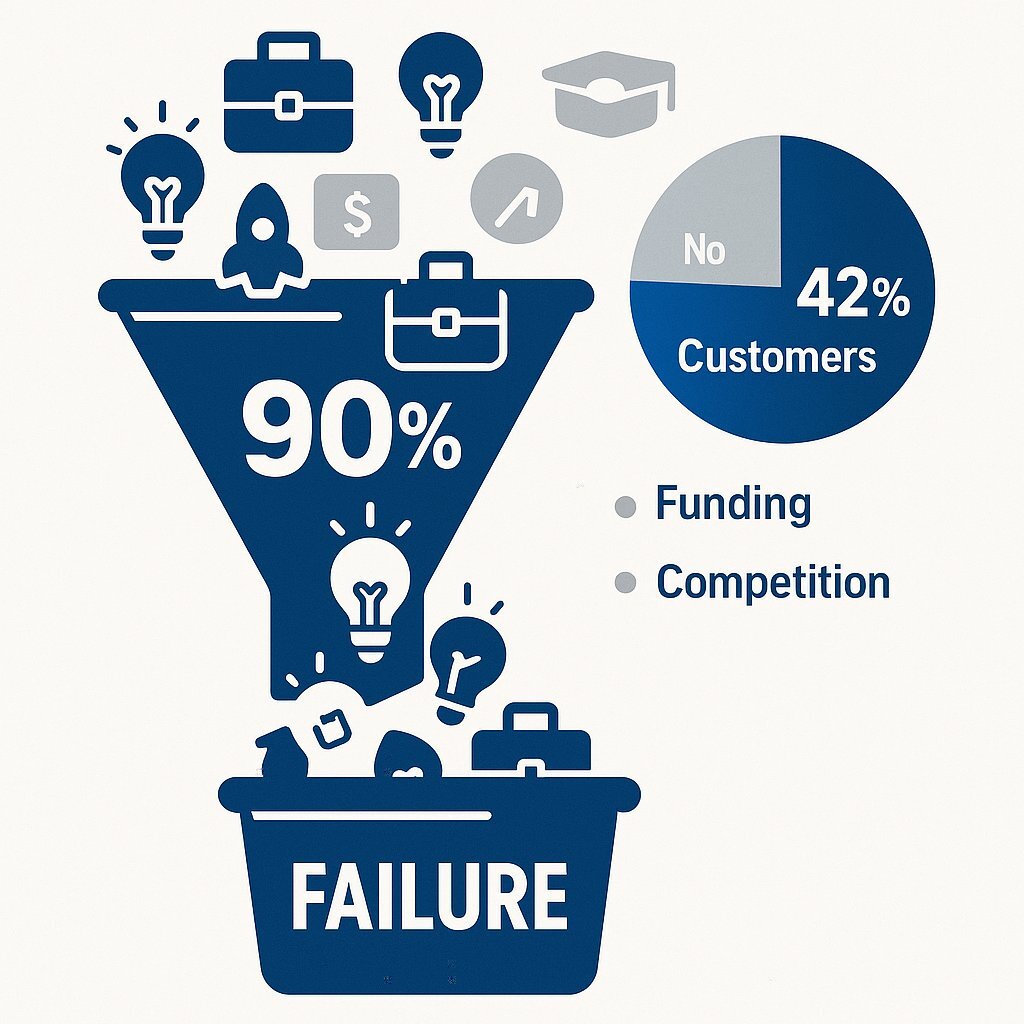
In the enterprise, this problem is magnified by the very structures designed to ensure stability. The path to innovation is often a gauntlet of bureaucracy, slow decision-making, and siloed departments, all of which extend development timelines. This inertia fosters a deep-seated fear of failure; in a complex hierarchy, it’s far safer to champion a "fully-featured" product that ticks every internal stakeholder's box than to launch a small, focused experiment. The result is a multi-million dollar, year-long project that, upon launch, is effectively a guess about what the market wanted 12 months ago.
This is a losing game. But what if you could change the rules?
What if you could replace high-risk gambles with a series of small, intelligent experiments? This is the promise of rapid prototyping and Minimum Viable Product (MVP) development. It’s not a shortcut or a way to build cheap software. It is a disciplined, data-driven methodology for systematically de-risking innovation. It’s a strategic weapon against uncertainty, designed to help you learn what to build before you bet the budget.
From Napkin Sketch to Market Test: Clarifying Your Innovation Toolkit
Before you can build anything, you must choose the right tool for the job. In the world of product development, the terms Proof of Concept (PoC), Prototype, and Minimum Viable Product (MVP) are often used interchangeably, leading to confused expectations, misaligned teams, and wasted resources. Each of these is a distinct tool designed to answer a specific question at a specific stage of the innovation lifecycle. Understanding the difference is the first step toward spending smarter.
Prototype vs. MVP vs. Proof of Concept (PoC): Choosing the Right Tool for the Job
Let's cut through the jargon. These tools are not a menu of options; they form a sequential de-risking funnel. You use a PoC to de-risk technology, a prototype to de-risk usability, and an MVP to de-risk the market. Skipping a step means you carry that specific risk forward into the next phase, where fixing it becomes exponentially more expensive.
- Proof of Concept (PoC): A PoC is a small, internal experiment designed to answer a single, binary question: "Is this technically feasible?". It has little to no user interface and is not meant for customers. Its purpose is to verify that a core piece of technology or a novel algorithm actually works as expected. Think of it as a lab experiment to test a fundamental hypothesis before you design the product around it.
- Prototype: A prototype is a visual and interactive representation of the product. Its primary purpose is to answer the question, "How will users interact with this?". Prototypes focus on user experience (UX) and user interface (UI), allowing stakeholders and potential users to click through screens and experience the product's workflow. While it may feel like a real product, its functionality is often simulated. It's a tool for gathering feedback on design, not on market demand.
- Minimum Viable Product (MVP): An MVP is the first version of your product that is released to real users. It is a functional, market-ready application with the absolute minimum feature set required to solve a core problem for a specific group of early adopters. The MVP is designed to answer the most critical question of all: "Does the market actually want this?" It is a tool for collecting the maximum amount of validated learning about your customers with the least amount of effort.
To make the distinction crystal clear, here is a framework for choosing the right tool based on the question you need to answer.
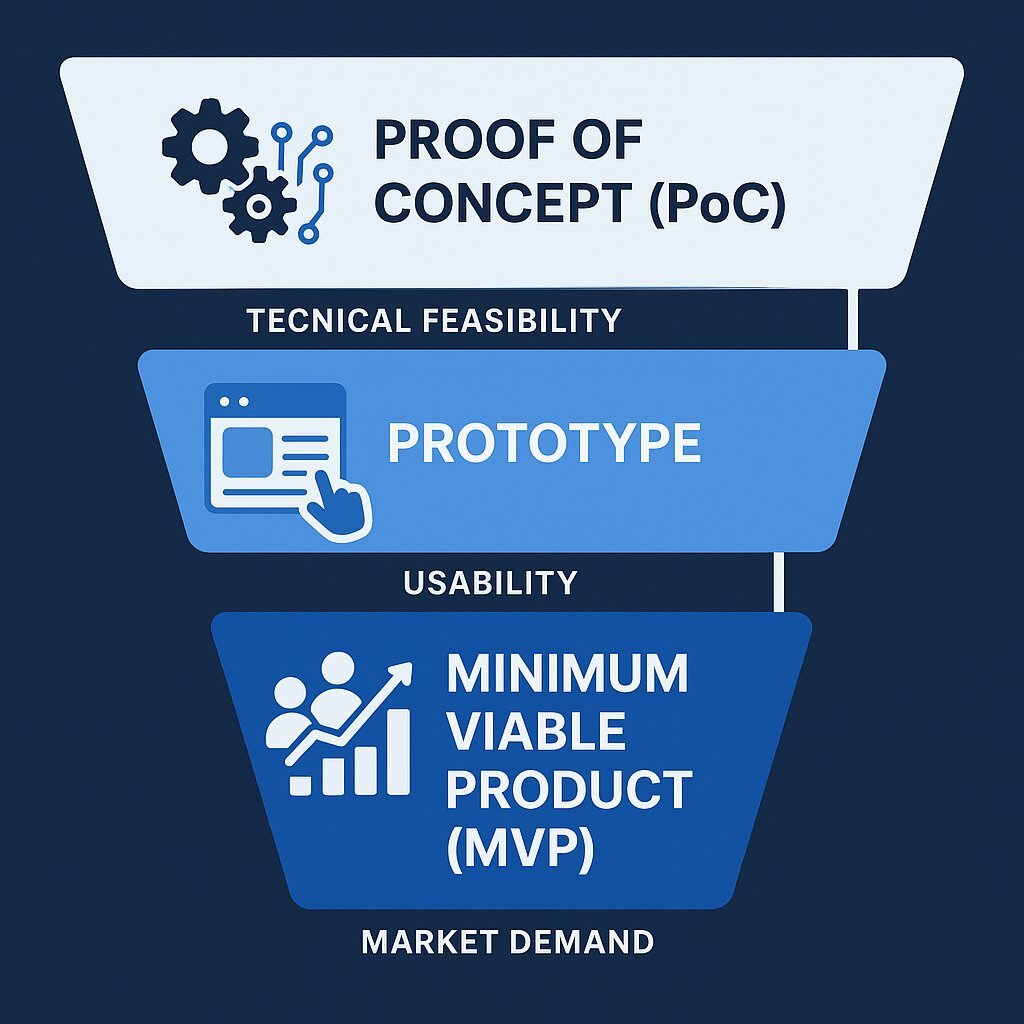
| Attribute | Proof of Concept (PoC) | Prototype | Minimum Viable Product (MVP) |
|---|---|---|---|
| Primary Purpose | Test technical feasibility | Test UI/UX & design concepts | Test market demand & core value prop |
| Key Question | "Can we build it?" | "How should we build it?" | "Should we build it?" |
| Functionality | None to minimal | Limited, often simulated | Fully functional core feature set |
| Audience | Internal (devs, stakeholders) | Internal, select users | Early adopters, real customers |
| Time/Cost | Very Low (days/weeks) | Low (weeks) | Moderate (weeks/months) |
| Outcome | Go/No-Go on technical approach | Refined UI/UX design | Validated learning, user data, pivot/persevere decision |
The MVP Philosophy: How to Learn Faster and Spend Smarter
The MVP is more than just a product development tactic; it’s a fundamental shift in how you approach innovation. It moves you away from the world of detailed business plans and five-year forecasts—which are often just well-researched fiction—and into the world of the scientific method. It’s about treating your business strategy as a series of testable hypotheses and using the MVP as the experiment to prove or disprove them.
The Core Principle: Maximizing Validated Learning
The concept of the MVP was popularized by Eric Ries in "The Lean Startup." He defines it as "that version of a new product which allows a team to collect the maximum amount of validated learning about customers with the least effort". The key word here is
learning . The primary output of an MVP is not revenue or a robust feature set; it is knowledge. Specifically, it is "validated" learning—facts derived from the actual behavior of real customers, not from surveys or focus groups.
This learning process is powered by a simple, continuous feedback loop: Build-Measure-Learn .
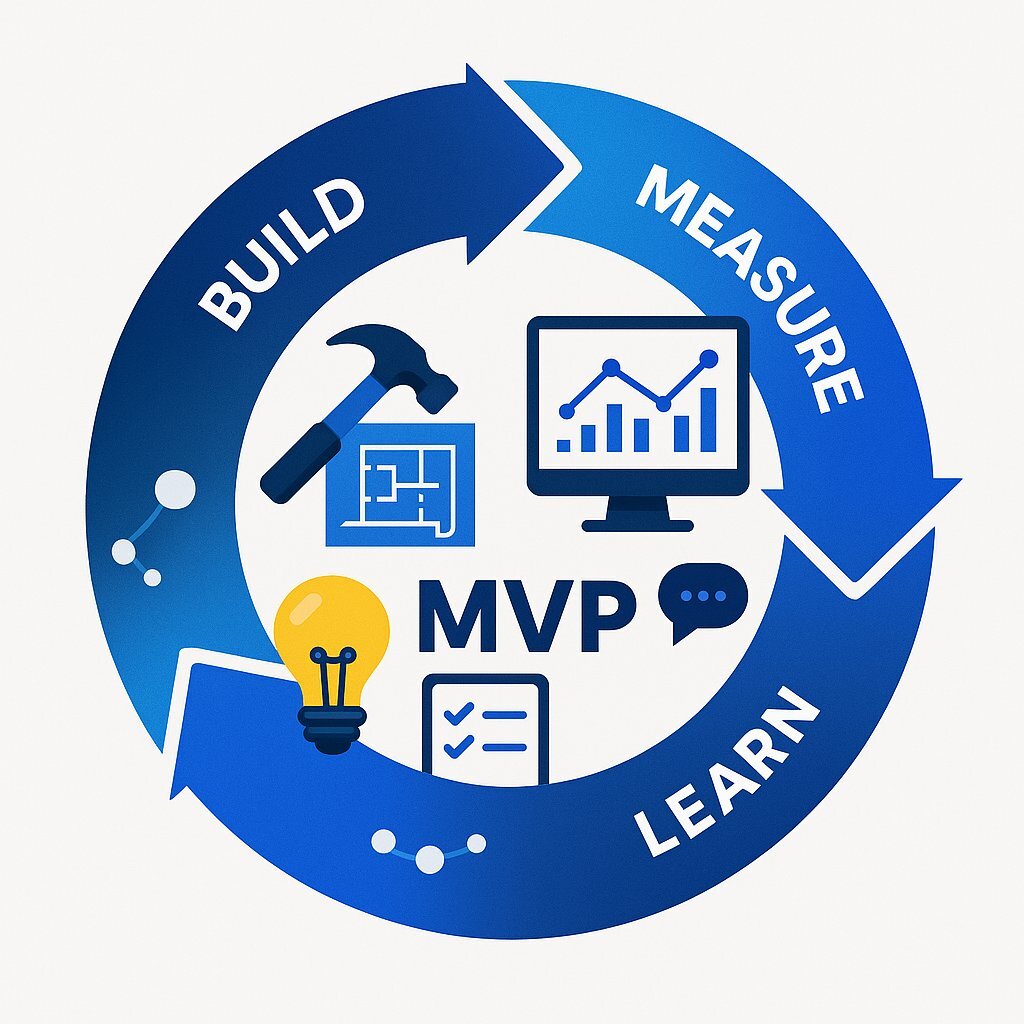
- Build: Start with a core hypothesis about a customer problem. Build the smallest possible product—the MVP—required to test that hypothesis.
- Measure: Release the MVP to a segment of early customers. Use analytics and direct feedback to measure their behavior. Seeing what people actually do with your product is infinitely more valuable than asking what they would do.
- Learn: Analyze the data. Did it validate or invalidate your initial hypothesis? This is the critical "pivot or persevere" moment. Based on what you’ve learned, you either continue with your current strategy (persevere) or make a fundamental change in direction (pivot).
The Unbeatable Business Case for the MVP Approach
Adopting an MVP strategy isn't about being cheap; it's about being intelligent with your resources. It directly addresses the primary risks that cause new products to fail.
- De-Risking Investment: The MVP is your insurance policy against building the wrong thing. It’s far better to learn that your core idea is flawed after a $50,000 MVP investment than after a $2 million, 18-month project that consumes your entire budget.
- Faster Time to Market: By focusing only on core functionality, you can get a product into the hands of real users in months, not years. This allows you to start building a user base, gathering feedback, and establishing a market presence while your competitors are still stuck in development meetings.
- Cost-Effectiveness: The MVP approach shatters the myth that all software development is prohibitively expensive. It forces you to focus your resources on the 20% of features that will deliver 80% of the value, dramatically reducing initial development costs. In fact, nearly half of businesses (48.6%) that use an MVP approach cite cost reduction as a key benefit.
- Attracting Investment and Securing Buy-In: Whether you're pitching to the board or to external VCs, a functional MVP with real user data is infinitely more persuasive than a PowerPoint presentation. It demonstrates not just a great idea, but the ability to execute and validate market demand.
For leaders who need to justify this approach to a CFO or budget committee, understanding the tangible costs is essential. An MVP is not a blank check; it is a scoped, phased investment.
| Development Stage | Activities | Cost Range (USD) | Estimated Timeline |
|---|---|---|---|
| 1. Pre-Development | Market Research, Prototyping, UI/UX Design | $2,500 – $30,000 | 3–6 weeks |
| 2. Development | Front-end, Back-end, Database, Integrations, QA | $13,000 – $115,000 | 8–18 weeks |
| 3. Post-Development | Launch, Initial Marketing, Maintenance | $3,500 – $30,000+ | Ongoing |
| Total Initial MVP | Sum of above activities | $19,000 – $175,000+ | ~3-6 months |
| Source: Adapted from industry analysis for 2025. |
Ultimately, the MVP serves as a cultural Trojan Horse for enterprise agility. While it is presented as a product development methodology, its true power lies in its ability to force a cultural shift. To execute an MVP properly, a team must abandon rigid, waterfall-style processes and embrace agile principles like sprints, user feedback, and iterative development. A single successful MVP can create a powerful internal case study, demonstrating that it's possible to launch a valuable product in three months instead of eighteen. This success creates a pull for agility across the organization, making the MVP a catalyst for broader, more impactful transformation.
The Enterprise Blueprint: A 5-Step Guide to Executing Your First MVP
Theory is valuable, but execution is everything. This blueprint breaks down the MVP process into five actionable steps, providing a clear framework for enterprise teams to follow.
Step 1: Isolate the Core Problem with User Story Mapping
The biggest mistake teams make is starting with a long list of features. This immediately puts you on the path to a bloated, unfocused product. Instead, start by deeply understanding the user's journey.
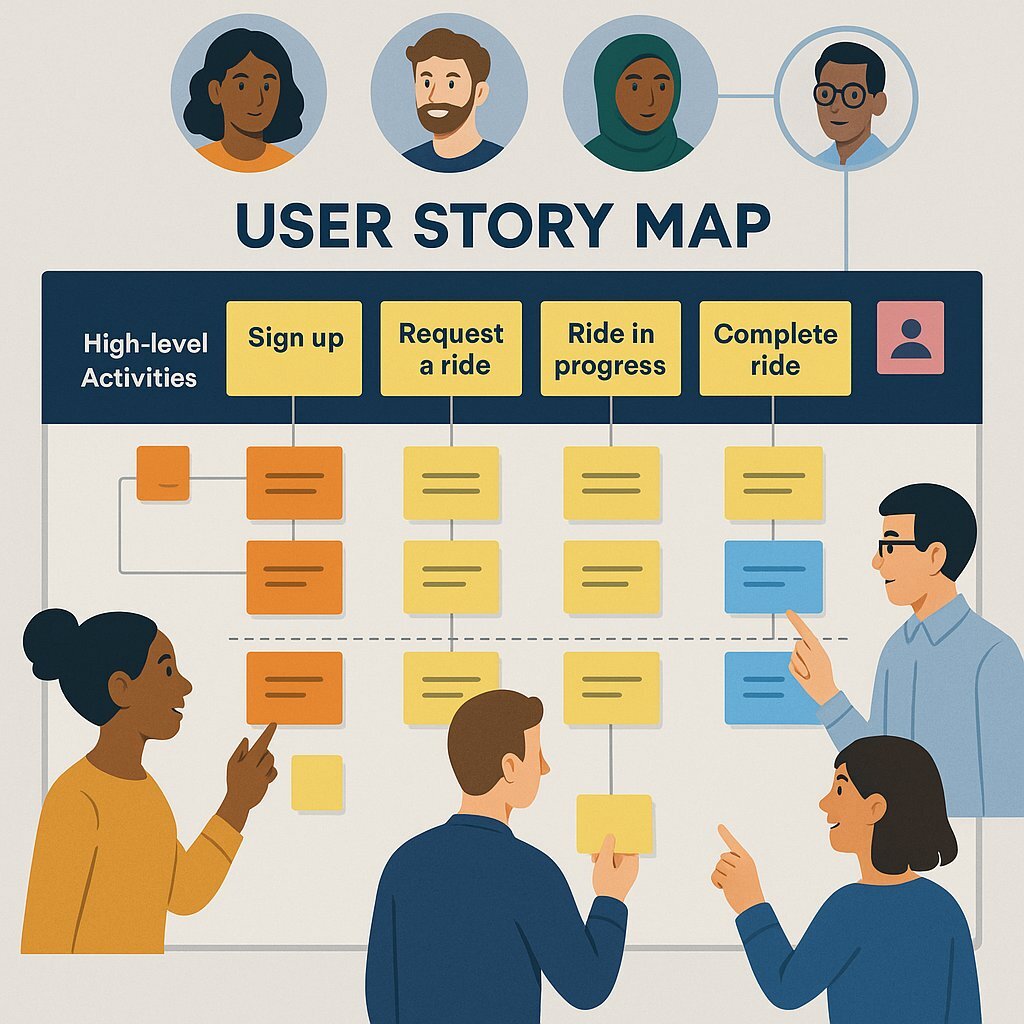
The best tool for this is User Story Mapping, a collaborative technique developed by Jeff Patton. It’s a visual exercise where the team maps out every step a user takes to accomplish a goal with your product.
- Identify User Personas: Define who you are building this for. What are their goals and pain points?.
- Create the Backbone: Map the high-level activities the user performs in chronological order. For a ride-sharing app, this might be: Request Ride, Take Trip, Pay for Ride, Rate Driver. This forms the horizontal axis of your map.
- Flesh out the Body: Under each high-level activity, brainstorm the specific tasks or user stories involved. Under Request Ride, you might have stories like Enter destination, Choose vehicle type, and Confirm pickup location. These are placed vertically under the corresponding activity.
The completed story map gives everyone—from engineers to executives—a shared, holistic understanding of the customer experience. It shifts the conversation from "What features should we build?" to "What problem are we solving?"
Step 2: Prioritize Ruthlessly—Carving Out the First Slice
With your user journey mapped out, prioritization becomes dramatically simpler. The team can now draw a horizontal line across the map. Everything above that line will be in the first release—your MVP.
The crucial rule here is that this first "slice" must represent a complete, end-to-end journey. It must allow the user to accomplish their primary goal, even if it does so in a very basic way. This addresses the common pitfall of building an MVP that is too "Minimum" and not "Viable". A user must be able to complete their core task and derive real value from it.
Step 3: Architecting for Speed and Scalability
Your ability to iterate quickly depends entirely on your technology choices. A slow, monolithic architecture can kill an MVP's momentum before it even starts. The goal is to choose a tech stack that enables speed without accumulating crippling technical debt.
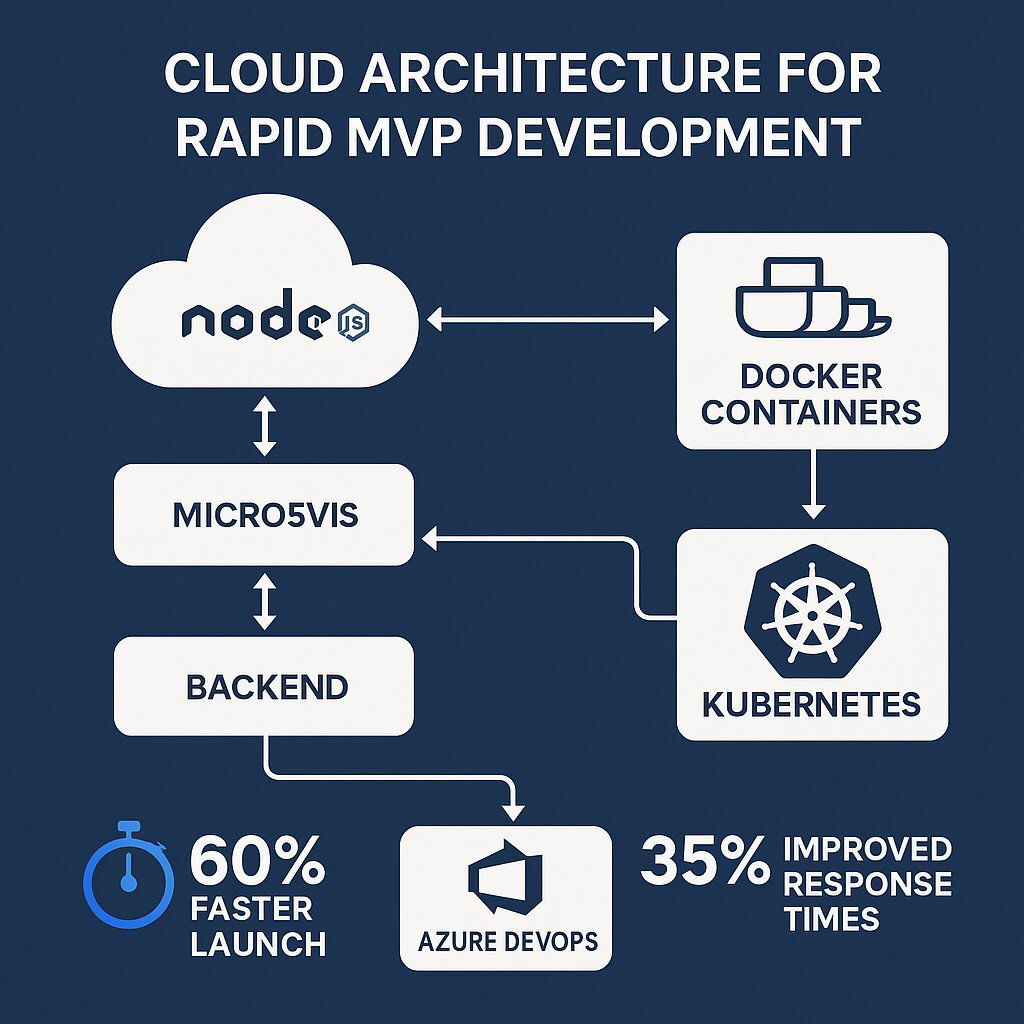
This is where a technology like Node.js shines for MVP development.
- Speed of Development: Node.js uses JavaScript for both the server-side and client-side, which means your developers can work across the full stack without context switching. This unified approach can accelerate MVP launches by up to 60%.
- Performance & Scalability: Its lightweight, event-driven architecture is built to handle many simultaneous connections efficiently. This is perfect for a new product that might need to scale its user base quickly. After switching to Node.js, PayPal was able to handle double the requests per second with a 35% faster response time.
- Rich Ecosystem: The Node Package Manager (npm) is the largest software registry in the world, with over 2.1 million ready-made packages. This allows your team to leverage existing solutions for common tasks instead of building everything from scratch, dramatically reducing development time.
This is where strategic technical decisions pay dividends. An expert team skilled in Rapid Agile Deployment, like ours at Baytech Consulting, can help you select a stack that balances speed with a solid foundation. Using modern tools like Docker, Kubernetes, and Azure DevOps, we ensure your MVP is built not just for a quick launch, but for future evolution. This "Foundation-First" approach is critical. While speed is the goal, building a sloppy, unmaintainable MVP creates a "rebuild trap". Data shows that developers can spend nearly half their week dealing with technical debt and bad code, costing businesses billions in lost opportunity costs globally. A well-architected MVP avoids this trap, enabling you to pivot and iterate without having to stop and rebuild from scratch.
To fully prepare your MVP for scale and success, learn from strategies that enable applications to efficiently support 1 million users and beyond. Laying this groundwork now will save vast amounts of time and money as your product grows.
Step 4: Launch, Measure, and Listen Intently
An MVP launch is not a Super Bowl commercial. It's a targeted release to a small group of early adopters—the users who feel the problem most acutely and are most willing to tolerate an imperfect solution in exchange for being heard.
Once launched, the "Measure" phase begins. This is where you collect both quantitative data (user analytics, conversion rates) and qualitative feedback (surveys, one-on-one interviews, support tickets). Your goal is to understand not just
what users are doing, but why they are doing it.
Step 5: The Data-Driven Decision: Pivot or Persevere
The data you collect is the result of your experiment. Now it's time to analyze it and make a decision.
- Persevere: If the data validates your core hypothesis—users are engaging, retention is strong, and they are getting value—then you persevere. You go back to your user story map, select the next most valuable slice of functionality, and begin the Build-Measure-Learn loop again.
- Pivot: If the data invalidates your hypothesis—users aren't using the core feature, churn is high, or they are using the product in a completely unexpected way—it’s time to pivot. A pivot is a structured course correction designed to test a new fundamental hypothesis. This isn't a sign of failure; it's a sign the process is working. You've learned something crucial at a low cost. Startups that successfully pivot one to two times experience 3.6 times better user growth and raise 2.5 times more money than those that don't.
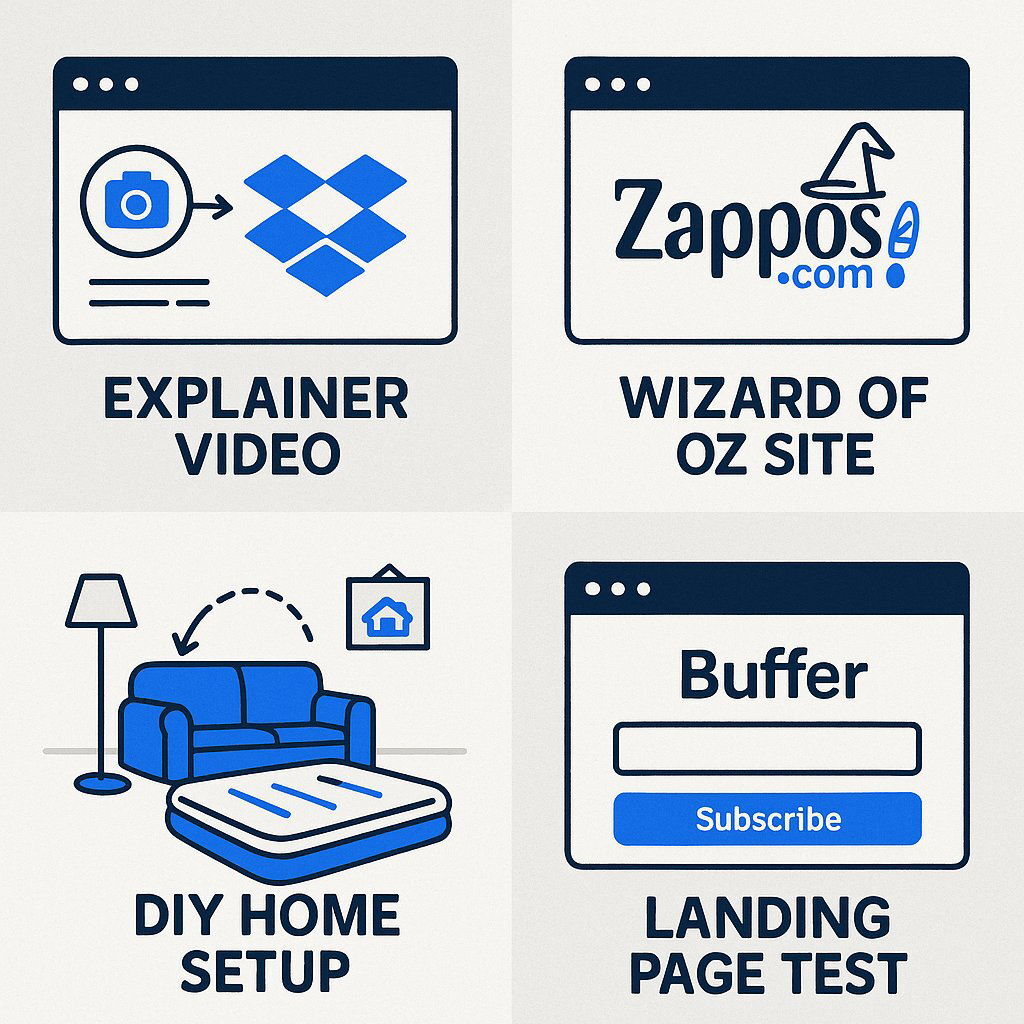
Lessons from the Titans: How MVPs Launched Billion-Dollar Businesses
This philosophy isn't just for startups. Some of the most successful companies in the world began with a simple, focused experiment to test a core assumption.
- Dropbox (The "Explainer Video" MVP): Before writing a single line of production code for their complex file-syncing product, the founders created a simple video that demonstrated how it would work. They targeted it at a tech-savvy audience and shared it on Digg. The video drove their beta waitlist from 5,000 to 75,000 people overnight, validating overwhelming market demand without a publicly available product.
- Zappos (The "Wizard of Oz" MVP): To test the radical hypothesis that customers would buy shoes online without trying them on first, founder Nick Swinmurn created a basic website with photos of shoes from local stores. When an order was placed, he would physically go to the store, buy the shoes, and ship them himself. The front-end appeared to be a fully functional e-commerce store, but the back-end was entirely manual. This allowed him to prove the business model before investing a single dollar in inventory or warehouse logistics.
- Airbnb (The "Solve Your Own Problem" MVP): The company started because its founders couldn't afford their San Francisco rent. They noticed a local design conference had caused all the hotels to be booked up. So, they put an air mattress in their living room, created a simple website with pictures, and offered a place to stay plus breakfast. They found three paying customers, validating the core idea that people would be willing to stay in a stranger's home.
- Buffer (The "Landing Page" MVP): To validate not just interest but purchase intent for a new social media scheduling tool, founder Joel Gascoigne created a simple two-page website. The first page described the product. If a visitor clicked the "Plans & Pricing" button, they were taken to a second page that said the product wasn't quite ready yet, but they could enter their email to be notified. By tracking the click-through rate to the pricing page, he could gauge how many people were serious enough to consider paying for it, validating the business model before development began.
Measuring True North: The Metrics That Prove Your MVP Is Working
An MVP is an experiment, and an experiment without measurement is just a hobby. To prove your MVP is working, you must track the right metrics. Vanity metrics like total downloads or registered users can be misleading. Instead, focus on actionable metrics that measure user engagement and the value your product delivers.
No single metric tells the whole story. A successful analysis requires looking at the relationships between them. For example, high user acquisition combined with high churn means your marketing is working but your product isn't delivering on its promise. Conversely, low acquisition but near-zero churn suggests you have a highly valuable product for a niche audience, and your challenge is marketing and discovery.
Here is a dashboard of the key metrics that matter, along with industry benchmarks to help you interpret your results.
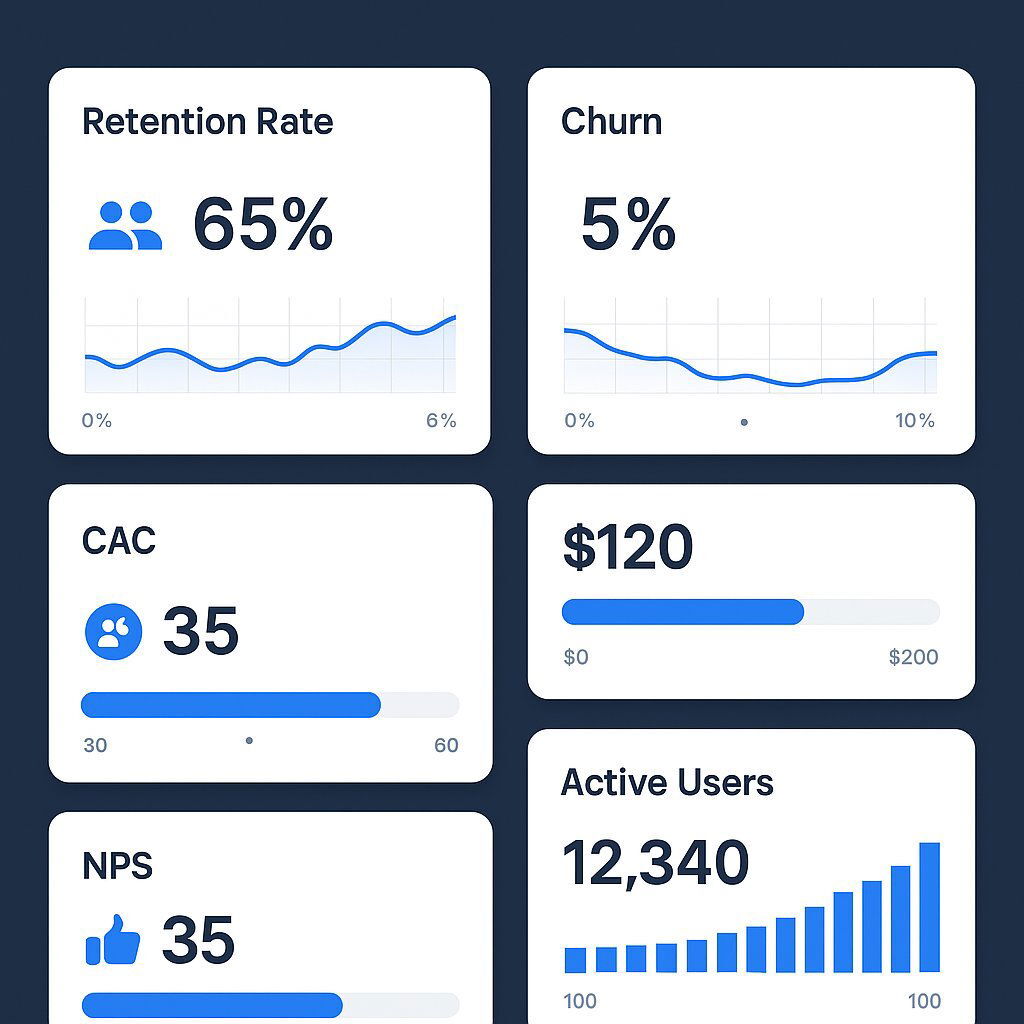
| Metric | What It Measures | Why It Matters for an MVP | Healthy Benchmark |
|---|---|---|---|
| User Retention Rate | % of users who return over time | The ultimate sign of product value. Are users coming back? | 25-30% after 90 days indicates strong product-market fit. |
| Churn Rate | % of users who stop using the product | High churn means the product isn't delivering on its promise. | < 5% monthly for a healthy SaaS product. |
| Customer Acquisition Cost (CAC) | The cost to acquire one new customer | Measures the efficiency of your go-to-market strategy. | Should be at least 3x lower than Customer Lifetime Value (CLV). |
| Net Promoter Score (NPS) | User willingness to recommend the product | A proxy for customer satisfaction and word-of-mouth potential. | A score > 30 is considered strong; > 50 is excellent. |
| Active Users (DAU/MAU) | Number of unique users in a day/month | Measures engagement. A steadily growing DAU/MAU ratio is key. | Successful MVPs often see 5-7% weekly growth in initial active users. |
Conclusion: Making the "Possible" Profitable
In today's fast-moving market, the key to successful innovation is not having the perfect idea from the start; it's having the best process for discovering what works. The rapid prototyping and MVP approach transforms innovation from a high-stakes, intuition-based gamble into a scientific, data-driven discipline. It systematically reduces risk, focuses resources on what truly matters to the customer, and dramatically increases your chances of building products that don't just launch, but win.
Your next step doesn't require a massive budget or a year of planning. This week, gather your product team and run a User Story Mapping session for your next big initiative. Visualize the entire customer journey and identify the single, thinnest slice that delivers a complete, valuable experience from end to end. That's your MVP. Now, ask the most important question: what is the fastest, most efficient way to build and test that? Rethink your approach to software maintenance and evolution so you’re prepared for success after launch, not just at launch.
Building the "art of the possible" requires a partnership between visionary leaders and expert practitioners. At Baytech Consulting, our Tailored Tech Advantage and Rapid Agile Deployment frameworks are designed to do just that—turn your boldest ideas into market-validated realities, faster. If you're ready to stop guessing and start learning, let's discuss what's possible. For even greater results, make sure your project avoids the hidden costs of configuration complexity and leverages smart budgeting for custom software so your innovation plans turn into thriving real-world products.
About Baytech
At Baytech Consulting, we specialize in guiding businesses through this process, helping you build scalable, efficient, and high-performing software that evolves with your needs. Our MVP first approach helps our clients minimize upfront costs and maximize ROI. Ready to take the next step in your software development journey? Contact us today to learn how we can help you achieve your goals with a phased development approach.
About the Author

Bryan Reynolds is an accomplished technology executive with more than 25 years of experience leading innovation in the software industry. As the CEO and founder of Baytech Consulting, he has built a reputation for delivering custom software solutions that help businesses streamline operations, enhance customer experiences, and drive growth.
Bryan’s expertise spans custom software development, cloud infrastructure, artificial intelligence, and strategic business consulting, making him a trusted advisor and thought leader across a wide range of industries.


